
Seneca is a city in Oconee County, South Carolina, United States. The population was 8,102 at the 2010 census. It is the principal city of the Seneca Micropolitan Statistical Area, an (MSA) that includes all of Oconee County, and that is included within the greater Greenville-Spartanburg-Anderson, South Carolina Combined Statistical Area. Seneca was named for the nearby Cherokee town of Isunigu, which English colonists knew as "Seneca Town".
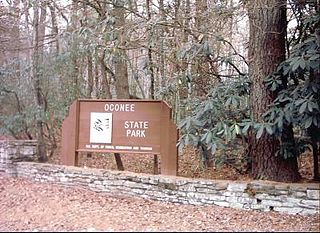
Oconee State Park is a state park located in the Blue Ridge Mountain region of South Carolina. This 1165-acre (472 ha) park has several recreational opportunities to choose from. They include cabins, camping, fishing and boating in the two small lakes located on the park grounds, hiking on eight nature/hiking trails, and several picnic and meeting facilities.

The Kingstree Historic District contains forty-eight properties situated along Main Street, Academy Street, and Hampton Street in the commercial area of downtown Kingstree, South Carolina. The district includes the courthouse, public library, railroad station, and numerous commercial buildings. The district is a fine collection of nineteenth-century vernacular commercial architecture. Details such as arched doorways and windows, cast-iron columns and pilasters, decorative or corbelled brickwork and pressed tin interior ceilings are present on most of the district's buildings. The Williamsburg County Courthouse, built ca. 1823, and designed by Robert Mills, is a fine example of Roman neoclassical design with its raised first floor, pediment with lunette, and Doric columns. In 1953-54 the courthouse underwent substantial remodeling on the exterior and interior, though it still reflects much of Mill's original design. With the exception of the courthouse, most of the buildings in the district were built between 1900 and 1920 when Kingstree enjoyed prosperity as a retail and tobacco marketing center of Williamsburg County. The majority of the buildings in the district are a visible record of this twenty-year growth and the historic fabric of the area remains substantially intact. The Kingstree Historic District was listed in the National Register of Historic Places June 28, 1982.
The Little River originally flowed 27.0 miles (43.5 km) from its headwaters in northern Oconee County, South Carolina near Salem into the Keowee River northeast of Seneca.
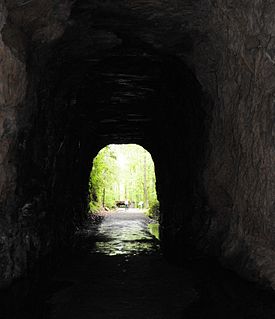
Stumphouse Mountain Tunnel in Oconee County, South Carolina is an incomplete railroad tunnel for the Blue Ridge Railroad of South Carolina in Sumter National Forest. The tunnel, along with nearby Issaqueena Falls, are now a Walhalla city park.

Oconee Station was established in 1792 as a blockhouse on the South Carolina frontier. Troops were removed in 1799. The site also encompasses the Williams Richards House, which was built in the early 19th century as a residence and trading post. The site is listed on the National Register of Historic Places in 1971 as Oconee Station and Richards House.

Southern Railway Passenger Station is railway passenger depot built ca. 1885 in Westminster, South Carolina. It is one of the oldest buildings in the community.

Ashley River Historic District is a historic district located in the South Carolina Lowcountry near Charleston, South Carolina, United States. The Historic District includes land from five municipalities, almost equally split between Charleston and Dorchester counties. The district includes dry land, swamps, and marshes of the Rantowles Creek and Stono Swamp watershed.

The Walhalla Graded School, built in 1901, is an historic building located at 101 E. North Broad Street in Walhalla, South Carolina. It was designed by noted Columbia architect William Augustus Edwards of the firm of Edwards and Walter and built by Grandy & Jordan of Greenville.

The Newberry Historic District is a historic district in Newberry, South Carolina, United States. Among its thirty-five contributing properties is a building dating back to 1789. It was listed on the National Register of Historic Places in 1974.

The McPhail Angus Farm is a farm at 320 Coyote Trail near Seneca, South Carolina in Oconee County. It is also known as the Tokena Angus Farm. It was named to the National Register of Historic Places as a historic district on November 7, 2007. It was named because of its significance to the transition from a nineteenth-century cotton farm to a twentieth-century, Upstate, cattle farm.
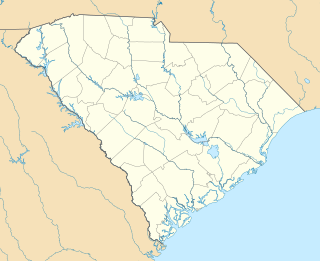
The old Oconee County Jail was a former jail located on Short Street in Walhalla, South Carolina, in Oconee County. The jail was located on the grounds of the current Oconee County Courthouse. It was named to the National Register of Historic Places on November 14, 1982 along with the Oconee County Cage. At the time of its listing, the jail was one of the few remaining nineteenth or twentieth century jails in upper northwestern South Carolina. It was demolished around 1985. Subsequently, it was delisted on December 12, 1989.

The Oconee County Cage is a former jail on wheels that is located at Browns Square Drive outside of the Oconee Heritage Center in Walhalla, South Carolina, USA in Oconee County. At the time of its listing, it was located on Church Street at the Oconee County Law Enforcement Center. It was named to the National Register of Historic Places on November 14, 1982 along with the Oconee County Jail. At the time of its listing, the cage was considered the most intact cage in South Carolina. Oconee County has preserved the cage as a reminder of the former harsh conditions faced by convicts in the early twentieth century.
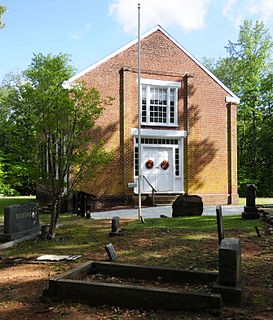
Old Pickens Presbyterian Church is a historic church in Seneca, South Carolina.
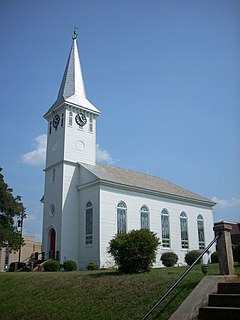
St. John's Lutheran Church, also known as St. John's German Evangelical Church of Walhalla, is a historic church at 301 W. Main Street in Walhalla, South Carolina.

The Salley Historic District, located in Salley, South Carolina, consists of 99 contributing structures and 51 non-contributing resources, and provides a good example of a South Carolina rural community during the late nineteenth and early twentieth centuries. The town, located in Aiken County, South Carolina and incorporated in 1887, is named after D. H. Salley, owner of a large nearby plantation who was instrumental in the area's original development. The Salley Historic District was listed on the National Register of Historic Places on October 27, 2000.

The Tamassee DAR School is a school in Tamassee, South Carolina, founded in 1919 by the Daughters of the American Revolution to serve the underprivileged children of Appalachia. Historic buildings can be observed on the DAR School campus. The school survives and thrives to this day, consistently graduating classes of children between the ages of 7 and 18.

Russell House was a historic inn located near Mountain Rest, Oconee County, South Carolina. It was built about 1867, and considerably expanded around 1890, and served as an inn for travelers between Walhalla and the mountain resort area. The Russell House, two storage buildings, and a privy were destroyed by fire in 1988. Located on the property are the contributing ruins of a log barn, a spring house, outhouse, garage, corn crib, and potato cellar.

Ram Cat Alley Historic District is a national historic district located at Seneca, Oconee County, South Carolina. It encompasses 18 contributing buildings in the central business district of Seneca. They were built between about 1887 and 1930. Notable buildings include the Patterson Building, Harper and Jones Building, C. F. Adams General Store, Old Seneca Post Office, and Richardson Theatre.

The historic Cherokee settlements were Cherokee settlements established in Southeastern North America up to the removals of the early 19th century. Several settlements existed prior to—and were initially contacted by—explorers and colonists of the colonial powers as they made inroads into frontier areas. Others were established later.























